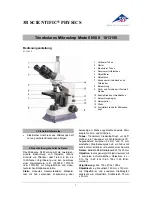
44
5
VARIOUS OBSERVATION METHODS
H
Final check and phase contrast observation
CT replaced by original eyepiece
Phase contrast objectives mounted
Corresponding phase contrast slider mounted and phase
rings centered
Aperture diaphragm ring set to maximum position 100/
PH/D
Field diaphragm opened to the size of the view
Illumination is adjusted
FOCUS ON THE SPECIMEN
Illustration 032 H: Settings for phase contrast: Final check and observation.
After removing or replacing a thick specimen, the bright ring and the dark
ring are likely to deviate each other, which will result in a decline of the image
contrast. So if happened, please repeat the steps as above.
If the specimen is not flat, it maybe need to repeat the centering steps for ob-
taining greater effect. Use the phase contrast objective to center the diaphragm,
according to the sequence of low to high magnification.
5.3. Polarization observation
5.3.1. Overview
By
polarization microscopy
, optically active or birefringent specimen structures can be
highlighted. For this purpose, the object to be examined is microscoped between two polarizing
filters. This leads to the formation of different color rings or to the illumination of the structures.
Minerals, but also many plastics or natural materials such as starch etc. show this effect. It is less
known that interesting structures can also be highlighted in living organisms, e.g. muscle fibers of
daphnia or rotifers. In industry, polarization is mainly used to characterize materials. If the layer
thickness of the sample is known, the resulting interference colors can also be used to determine
the type of material. In materials research, polarization is also used, for example, to investigate
tension in the material by stress birefringence. Especially injection moulded parts or plastic foils or
fibres can be examined for manufacturing defects. The classical application is of course geology
/ mineralogy, in which thin sections of rock are examined in polarized light. Due to the spectral
distribution, halogen illumination is more suitable than LED in polarization microscopy.
Simvastatin crystals:
source: Bresser GmbH
Summary of Contents for NE620T
Page 60: ...60 9 NOTES COMMENTS 9 NOTES COMMENTS ...
Page 61: ...61 NOTES COMMENTS 9 ...
Page 62: ...62 9 NOTES COMMENTS 9 NOTES COMMENTS ...
Page 63: ...63 NOTES COMMENTS 9 ...
















































